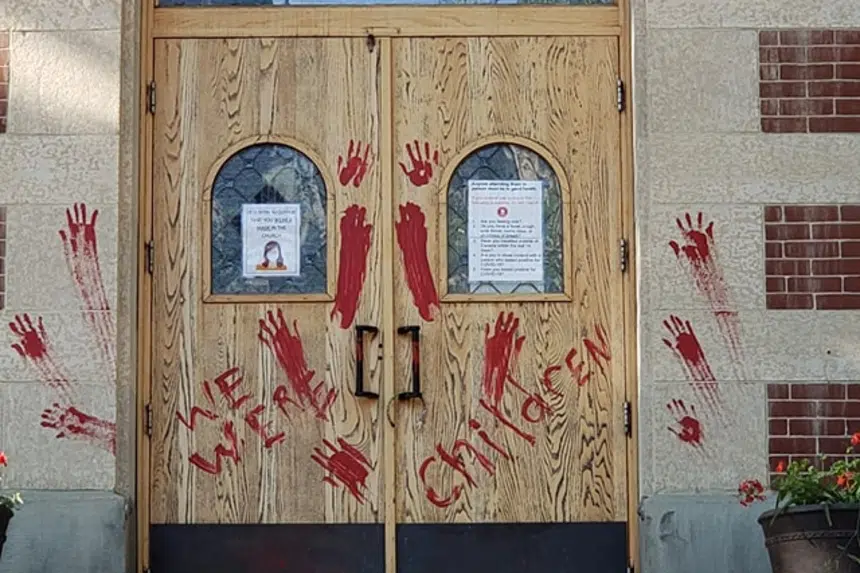The doors and front steps of a downtown Saskatoon church were desecrated with red paint Thursday afternoon in response to the discovery of hundreds of unmarked graves at the former Marieval Indian Residential School.
Pictures shared on social media showed the paint splattered on the steps, the doors and sign of St. Paul’s Co-Cathedral.
The words “We Were Children” were painted on the church door with handprints also painted throughout the property.
On Thursday, the Cowessess First Nation announced the initial discovery of 751 unmarked graves at the former residential school.
The Catholic Church has often been criticized for its role in the residential school system. Many have pointed to the reluctance to provide records relating to burial grounds.
A Saskatoon police spokesperson confirmed two people painted the words and handprints on the church, “however, a larger group was present for the demonstration.”
Officers spoke with church officials and the demonstrators. No charges have been laid.
By Friday morning the paint had been removed with only a few splatters of red paint remaining on the sidewalk outside the church.
On Thursday, the Catholic Bishops of Saskatchewan addressed the discovery at Cowessess First Nation, pledging to listen and address the Truth and Reconciliation Commission’s Calls to Action.
“We offer our condolences but we know that this is not enough and our words must move to concrete action,” the statement said. “We are here to listen to you as you communicate those ways we can walk with you in addressing the Calls to Action, rebuilding relations, addressing issues of justice, and working towards a more just society.”
The statement went on to say the bishops stand by Cowessess First Nation Chief Cadmus Delorme, specifically Delorme’s stating “the truth is there.”
“We need to hear that truth. We have heard you telling us that healing and reconciliation can only come after the hard work of listening to the truth, a spirit of repentance, concrete acts of justice, and working with you to bring transformation and healing,” the statement said in response to Delorme.
The finding at Cowessess comes after another discovery at the Tk’emlúps te Secwépemc First Nation in B.C., which announced the discovery of a burial site near the former Kamloops Indian Residential School. The site contains the remains of 215 children, according to early findings.
Bishop Mark Hagemoen with the Roman Catholic Diocese of Saskatoon understands why the prominent cathedral was vandalized Thursday.
He just doesn’t want to see any demonstration or protest devolve into violence.
“When people are confronting, when wounds are torn open again, anger and associated emotions are legitimate,” Hagemoen said. “But we can’t end up in a circle of hate and violence.”
St. Paul Co-Cathedral has turned into common protest and demonstration spot after the discovery of the remains of 215 children in Kamloops.
With more discoveries and the accompanying anger and outrage expected over the coming months, Hagemoen said bishops in Saskatchewan are reaffirming their commitment to the Truth and Reconciliation Commission’s Calls to Action.
“This is a flashpoint and people are really hurting at the news of the discovery,” he said. “We need to honour that properly, and that’s my aim and my commitment.”
Hagemoen said reconciliation is happening a lot slower than many people expected.
“We seem to hardly be making progress,” Hagemoen said.
With gravesites at former residential schools previously documented by the TRC, Hagemoen acknowledged other calls to action await.
“How do we move forward in a way that is helpful and constructive, and of course honours people’s anger and need to grieve? That’s a journey and a process we need to be patient with,” Hagemoen said.
“We’ve come a ways, but we’ve got a ways to go.”











